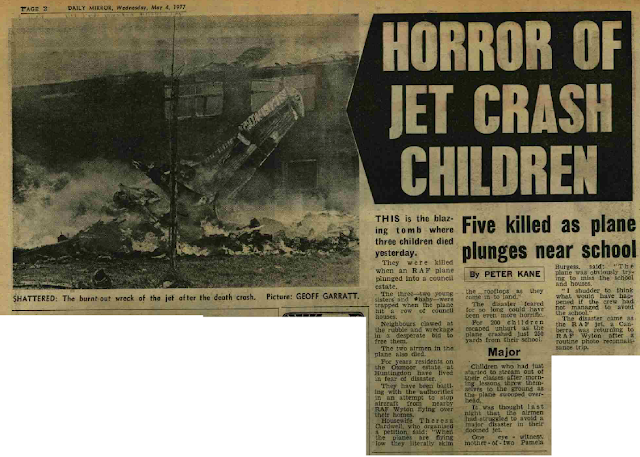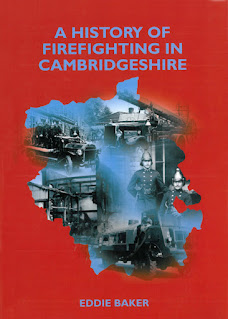 |
| Aftermath of the Canberra plane crash in Huntingdon, England 1977 |
 |
 |
| Location of the crash site as it appears today |
The RAF Canberra PR9 was returning from photographic tasks in Scotland. The crew were instructed to perform a ‘Practice Pan leading to an asymmetric recovery and overshoot’.
Asymmetric flying is when the power to one engine is reduced to idle speed to simulate engine failure. It then becomes critical that the pilot retains balance using the correct sequence of fin/rudder control and speed. If too much power is applied to the ‘live’ engine, or too quickly, then the aircraft will roll, the nose will drop and control is lost. This happens very quickly and if the aircraft is too close to the ground it’s unlikely to recover. There have been numerous other incidents of this happening during the time the Canberra was operational. Some of these other incidents also resulted in the deaths of the crew.
The aircraft crashed between two rows of houses at the end of Norfolk Road, Huntingdon. This was just 1.8 miles from the runway at RAF Wyton. Fire from ruptured fuel tanks almost completely destroyed 7 houses and badly damaged 9 others. Tragically, three children were killed after becoming trapped in the burning houses. They were aged just 4 months, 2 years and 4 years old.
The navigator ejected at around 100ft, which is about the minimum height required for a seat to work effectively. Although the ejector seat had detached and parachute deployed, the seat trajectory was into the path of the resulting fireball which is why the navigator did not survive. His severely charred body was found close to his ejector seat. Meanwhile, the pilot remained at his controls until the seat ejected his body from the wreckage on impact. It seems he was still trying to regain control of the aircraft in the final seconds before impact. The navigator had failed to secure his helmet which was found intact nearby, although this was not a contributing factor to his death. The navigators helmet was shown on television news reports from the time (photo below).
 |
| The navigators helmet recovered from the scene |
Here's a selection of photographs from the accident investigation report reproduced here with permission. These may not have been previously published and those of a sensitive nature have been omitted.
Gas and electricity had to be disconnected affecting about 140 houses on the estate and hot meals were provided at the local school. The site was cleared of wreckage by 17:00 on Sunday 8 May 1977. Demolition of burnt out houses began Monday 9 May.
The board of enquiry investigating the crash concluded:
“The aircraft did not roll out of the finals turn but more than sufficient power to overshoot was applied to the port engine. The Board concludes that the pilot must have applied overshooting power before rolling the wings level. On this occasion, a combination of power on the engine outside the turn to the limit of directional control and aileron applied to level the wings or to counter the effect of wind gusts would have been sufficient to achieve fin stall. In the PR9 the powered rudder masks all warning of approaching fin stall, and the pilot probably did not realise that he was close to fin stall when it occurred. The Board believed that fin stall is the most probable cause of the accident”
These two diagrams reconstruct the Canberra's final rapid descent:
 |
| RAF Canberra PR9 photographic reconnaissance jet |
 |
| Flight International 17 December 1977 |
I was pleased to learn that in 2017 a memorial service was held at the crash site to mark the 40th Anniversary. A memorial bench was unveiled which features five white doves to represent those who lost their lives. A fitting tribute to a tragic event, as reported by the Huntingdon Hunts Post.

























I was the first ambulance man on scene that day,my colleague was John Robinson from Godmanchester , I could tell my own story of that day if someone was to ask
ReplyDeleteYes please. I would be very interested to hear about your memories from that day if you're willing to share them here. Please let me know by posting another comment here and include a contact email address (optional) if you would like to get in touch with me, which will not be made public. Alternatively, you can simply post what you would like me to publish directly here with or without your name. I can include whatever you want. Sorry for the delay, I've had a technical problem with my blog which is now resolved.
DeleteMy family and I lived in one of the houses affected by this tragedy. Remember it like it was yesterday. Funnily enough the John Robinson mentioned above was also the dad of a schoolfriend of mine.
DeleteMy family and I lived in 69. My baby brother was killed. My mum and I came to the 40th Anniversary memorial from Australia. It gave a little closure to many years of grief in an odd way. I bought the bear that an emergency responder gave me at the time, he wasnt at the memorial unfortunately. I would have loved to have seen him to thank him for my childhood companion.
ReplyDeleteI was a student at Huntingdon college at the time. Myself and a class of students looking out the window saw the plane fall out of the sky. 5 of us ran out the room hot in a car and arrived at the scene, about half a mile away. We arrived before any if the emergency services. What we found was a scene out of a war movie. We were all in shock. We could hear children screaming, but no one was able to rescue them. Flayed started to activate and fly across the ground and indeed under some parked cars. The five of us were able to drag a couple of cars away from danger. I in fact saw one of the crew members still in his seat, impaled into the concrete pathway. A sight I will never forget. The fire brigade arrived at this point. I pointed to the crew member on the ground and a fire put a blanket over him. I have since found a photo of a priest kneeling next to him saying a prayer. Boy did we get in trouble from the principal at the college for leaving the classroom and driving to the crash scene!
ReplyDeleteHi, I cannot recall giving you those pieces! I was 13 at the time. There were bits of wreckage all over the streets. My late father Graham Hall was indeed deputy head of HCJS at the time and as I understand was on a visit with social services in Norfolk Road at the time, thus one of the first people on scene. There's a brief quote from him in the London Evening Standard from that evening. Even as someone who had lived in London during the horrors of WW2 Luftwaffe bombings and V1/V2 in 1944/45 and ex-RAF himself he was still extremely upset particularly at the loss of the children. I can recall local opinion being very much of praising the pilot for trying to miss Sapley school, which has been demolished now, but we will never know his last thoughts or intentions. As I look back now years later I still think about the chance bad luck of this accident. 50 yards to the left and the Canberra would have crashed on a wide open playing field, five seconds flying time later and it would have been in open farmland. I still go back every few years and walk along the streets of my childhood and along the end of Norfolk Road. People may pass along that path every day but not know what happened there. Those with a more observant nature may ponder why some of those houses are built with different colour bricks to the rest. RIP to the children and crew of XH137.
ReplyDeleteA very nice surprise to hear from you. I started to wonder whether my memory is wrong and I got those pieces of wreckage from someone else - perhaps at school. I certainly remember visiting your house for some 'swaps'. I may have swapped my WW2 army gas mask with bag for a few things which included a green officers cap from the 1950's, which I thought was your father's from some reason but perhaps not if he was ex-RAF. I'm pretty sure I also got from you a 20mm brass shell with head, many clips of brass blank 5.56mm M16 cartridges with a cotton bandolier and two M16 Colt magazines. Does that jog your memory? I assume the US stuff came from the nearby American airbase? I've no memory of how we met and agreed the swap meeting. I can even remember walking back home to Lammas gardens on my own carrying lots of stuff. I would be very pleased to hear more from you. If you send a reply with your email address I'll get in touch and will not publish your email address here.
Delete